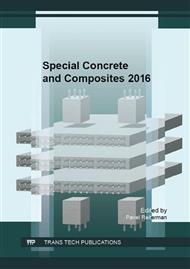p.201
p.207
p.216
p.222
p.228
p.235
p.241
p.247
p.254
The Carbonation Depth of Fine Recycled Aggregate Concrete
Abstract:
This paper is focused on carbonation resistance of fine recycled aggregate (FRA) concrete. Durability of FRA concrete is connected with uncertainties and doubts. One of the most unknown aspects of FRA cocnrete is carbonation resistance. This paper presents results of carbonation depth of FRA concrete. The FRA was originated from crushed construction and demolition (C&D) waste. There were prepared a total four concrete mixture. The first mixture was reference, did not include the FRA. In other concrete mixtures, natural sand was replaced by the FRA in various replacement ratios, specifically 10%, 20% and 30%. All prepared concrete mixtures were designated with the same parameters for clear comparison. From the test results it is possible to say that the use of the FRA as partial replacement of natural sand in concrete influences carbonation resistance of concrete. The carbonation depth was higher for concrete samples with the use of FRA. However it is possible to say that according to the carbonation resistance, the FRA concrete is possible to be used in the same applications as conventional concrete but it is necessary to verify this results.
Info:
Periodical:
Pages:
228-232
Citation:
Online since:
December 2016
Authors:
Keywords:
Price:
Сopyright:
© 2017 Trans Tech Publications Ltd. All Rights Reserved
Share:
Citation:


